Modeling Coastal Freak Wave Occurrence
Abstract
1. Introduction
2. The Simulation CFW Event
3. Numerical Simulations
3.1. Governing Equations
3.2. Numerical Scheme
3.3. Model Setup
3.4. Model Validation and Convergence Analysis
4. Results and Discussion
4.1. Simulation Cases
4.2. Results without Armor Blocks Installation
4.3. Results with Armor Blocks Installation
4.4. Discussion
5. Conclusions
Author Contributions
Funding
Acknowledgments
Conflicts of Interest
References
- Kharif, C.; Pelinovsky, E. Physical mechanisms of the rogue wave phenomenon. Eur. J. Mech. B Fluids 2003, 22, 603–634. [Google Scholar] [CrossRef]
- Tamura, H.; Waseda, T.; Miyazawa, Y. Freakish sea state and swell-windsea coupling: Numerical study of the Suwa-Maru incident. Geophys. Res. Lett. 2009, 36, 36280. [Google Scholar] [CrossRef]
- Waseda, T.; Tamura, H.; Kinoshita, T. Freakish sea index and sea states during ship accidents. J. Mar. Sci. Technol. 2012, 17, 305–314. [Google Scholar] [CrossRef]
- Cavaleri, L.; Bertotti, L.; Torrisi, L.; Bitner-Gregersen, E.; Serio, M.; Onorato, M. Rogue waves in crossing seas: The Louis Majesty accident. J. Geophys. Res. Ocean. 2012, 117. [Google Scholar] [CrossRef]
- Toffoli, A.; Waseda, T.; Houtani, H.; Cavaleri, L.; Greaves, D.; Onorato, M. Rogue waves in opposing currents: An experimental study on deterministic and stochastic wave trains. J. Fluid Mech. 2015, 769, 277–297. [Google Scholar] [CrossRef]
- Mori, N.; Liu, P.C.; Yasuda, T. Analysis of freak wave measurements in the Sea of Japan. Ocean Eng. 2002, 29, 1399–1414. [Google Scholar] [CrossRef]
- Janssen, P.A. Nonlinear four-wave interactions and freak waves. J. Phys. Oceanogr. 2003, 33, 863–884. [Google Scholar] [CrossRef]
- Onorato, M.; Osborne, A.R.; Serio, M.; Bertone, S. Freak Waves in Random Oceanic Sea States. Phys. Rev. Lett. 2001, 86, 5831–5834. [Google Scholar] [CrossRef]
- Toffoli, A.; Gramstad, O.; Trulsen, K.; Monbaliu, J.; Bitner-Gregersen, E.; Onorato, M. Evolution of weakly nonlinear random directional waves: Laboratory experiments and numerical simulations. J. Fluid Mech. 2010, 664, 313–336. [Google Scholar] [CrossRef]
- Dysthe, K.; Krogstad, H.E.; Müller, P. Oceanic rogue waves. Annu. Rev. Fluid Mech. 2008, 40, 287–310. [Google Scholar] [CrossRef]
- Mori, N.; Onorato, M.; Janssen, P.A.E.M. On the Estimation of the Kurtosis in Directional Sea States for Freak Wave Forecasting. J. Phys. Oceanogr. 2011, 41, 1484–1497. [Google Scholar] [CrossRef]
- Sergeeva, A.; Slunyaev, A. Rogue waves, rogue events and extreme wave kinematics in spatio-temporal fields of simulated sea states. Nat. Hazards Earth Syst. Sci. 2013, 13, 1759–1771. [Google Scholar] [CrossRef]
- Slunyaev, A.V.; Pelinovsky, E. Role of Multiple Soliton Interactions in the Generation of Rogue Waves: The Modified Korteweg–de Vries Framework. Phys. Rev. Lett. 2016, 117, 214501. [Google Scholar] [CrossRef] [PubMed]
- Slunyaev, A. On the optimal focusing of solitons and breathers in long-wave models. Stud. Appl. Math. 2019, 142, 385–413. [Google Scholar] [CrossRef]
- Tsai, C.-H.; Su, M.-Y.; Huang, S.-J. Observations and conditions for occurrence of dangerous coastal waves. Ocean Eng. 2004, 31, 745–760. [Google Scholar] [CrossRef]
- Kharif, C.; Pelinovsky, E.; Slunyaev, A. Rogue Waves in the Ocean; Springer Science & Business Media: Berlin/Heidelberg, Germany, 2009. [Google Scholar]
- Didenkulova, I.; Anderson, C.J. Freak waves of different types in the coastal zone of the Baltic Sea. Nat. Hazards Earth Syst. Sci. 2010, 10, 2021–2029. [Google Scholar] [CrossRef]
- Nikolkina, I.; Didenkulova, I. Rogue waves in 2006–2010. Nat. Hazards Earth Syst. Sci. 2011, 11, 2913–2924. [Google Scholar] [CrossRef]
- Nikolkina, I.; Didenkulova, I. Catalogue of rogue waves reported in media in 2006–2010. Nat. Hazards 2012, 61, 989–1006. [Google Scholar] [CrossRef]
- Didenkulova, E. Catalogue of rogue waves occurred in the World Ocean from 2011 to 2018 reported by mass media sources. Ocean Coast. Manag. 2020, 188, 105076. [Google Scholar] [CrossRef]
- Doong, D.J.; Peng, J.P.; Chen, Y.C. Development of a warning model for coastal freak wave occurrences using an artificial neural network. Ocean. Eng. 2018, 169, 270–280. [Google Scholar] [CrossRef]
- Doong, D.J.; Chen, S.T.; Chen, Y.C.; Tsai, C.H. Operational probabilistic forecasting of coastal freak waves by using an artificial neural network. J. Mar. Sci. Eng. 2020, 8, 165. [Google Scholar] [CrossRef]
- Slunyaev, A.; Didenkulova, I.; Pelinovsky, E. Rogue waters. Contemp. Phys. 2011, 52, 571–590. [Google Scholar] [CrossRef]
- Goda, Y. Derivation of unified wave overtopping formulas for seawalls with smooth, impermeable surfaces based on selected CLASH datasets. Coast. Eng. 2009, 56, 385–399. [Google Scholar] [CrossRef]
- Van der Meer, J.W.; Allsop, N.W.H.; Bruce, T.; De Rouck, J.; Kortenhaus, A.; Pullen, T.; Schüt-trumpf, H.; Troch, P.; Zanuttigh, B. EurOtop, Manual on Wave Overtopping of Sea Defences and Related Structures. An Overtopping Manual Largely Based on European Research, but for Worldwide Application, 2nd ed. 2018. Available online: www.overtopping-manual.com (accessed on 3 January 2022).
- Takahashi, T.; Imamura, F.; Shuto, N. Research on flows and bathymetry variations by tsunami: The Case of Kesennuma Bay, Japan, due to the 1960 Chilean Tsunami. Tsunami Eng. Tech. Rep. 1992, 9, 185–201. [Google Scholar]
- Bruce, T.; Pearson, J.; Allsop, W.; Smith, J.M. Hazards at coast and harbour seawalls—Velocities and trajectories of violent overtopping jets. In Proceedings of the 28th International Conference on Coastal Engineering, Cardiff, Wales, 7–12 July 2003. [Google Scholar] [CrossRef]
- Peng, Z.; Zou, Q.-P. Spatial distribution of wave overtopping water behind coastal structures. Coast. Eng. 2011, 58, 489–498. [Google Scholar] [CrossRef]
- Quang, T.T.; Van, T.N. Numerical study of wave overtopping on sea-dikes with crown-walls. J. Hydro-Environ. Res. 2014, 8, 367–382. [Google Scholar] [CrossRef]
- Didier, E.; Neves, D.R.C.B.; Martins, R.; Neves, M.G. Wave interaction with a vertical wall: SPH numerical and experimental modeling. Ocean. Eng. 2014, 88, 330–341. [Google Scholar]
- Monaghan, J.J.; Cas, R.A.; Kos, A.M.; Hallworth, M. Gravity currents descending a ramp in a stratified tank. J. Fluid Mech. 1999, 379, 39–69. [Google Scholar] [CrossRef]
- Gingold, R.A.; Monaghan, J.J. Smoothed particle hydrodynamics: Theory and application to non-spherical stars. Mon. Not. R. Astron. Soc. 1977, 181, 375–389. [Google Scholar] [CrossRef]
- Lucy, L.B. A numerical approach to the testing of the fission hypothesis. Astron. J. 1977, 82, 1013–1024. [Google Scholar] [CrossRef]
- Monaghan, J. Simulating Free Surface Flows with SPH. J. Comput. Phys. 1994, 110, 399–406. [Google Scholar] [CrossRef]
- Monaghan, J.; Kocharyan, A. SPH simulation of multi-phase flow. Comput. Phys. Commun. 1995, 87, 225–235. [Google Scholar] [CrossRef]
- Morris, J.P.; Fox, P.J.; Zhu, Y. Modeling Low Reynolds Number Incompressible Flows Using SPH. J. Comput. Phys. 1997, 136, 214–226. [Google Scholar] [CrossRef]
- Morris, J.; Monaghan, J. A Switch to Reduce SPH Viscosity. J. Comput. Phys. 1997, 136, 41–50. [Google Scholar] [CrossRef]
- Lo, E.; Shao, S. Simulation of near-shore solitary wave mechanics by an incompressible SPH method. Appl. Ocean Res. 2002, 24, 275–286. [Google Scholar] [CrossRef]
- Gotoh, H.; Shao, S.; Memita, T. SPH-LES Model for Numerical Investigation of Wave Interaction with Partially Immersed Breakwater. Coast. Eng. J. 2004, 46, 39–63. [Google Scholar] [CrossRef]
- Khayyer, A.; Gotoh, H.; Shao, S. Corrected Incompressible SPH method for accurate water-surface tracking in breaking waves. Coast. Eng. 2008, 55, 236–250. [Google Scholar] [CrossRef]
- Gomez-Gesteira, M.; Cerqueiro, D.; Crespo, A.J.C.; Dalrymple, R. Green water overtopping analyzed with a SPH model. Ocean Eng. 2005, 32, 223–238. [Google Scholar] [CrossRef]
- Shao, S.; Ji, C.; Graham, D.I.; Reeve, D.E.; James, P.W.; Chadwick, A.J. Simulation of wave overtop-ping by an incompressible SPH model. Coast. Eng. 2006, 53, 723–735. [Google Scholar] [CrossRef]
- Didier, E.; Neves, M.G. Wave overtopping of a typical coastal structure of the Portuguese coast using a SPH model. J. Coast. Res. 2009, 1, 496–500. [Google Scholar]
- Rao, X.; Li, L.; Amini, F.; Tang, H. Numerical study of combined wave and surge overtopping over RCC strengthened levee systems using the smoothed particle hydrodynamics method. Ocean Eng. 2012, 54, 101–109. [Google Scholar] [CrossRef]
- Pu, J.H.; Shao, S. Smoothed Particle Hydrodynamics Simulation of Wave Overtopping Characteristics for Different Coastal Structures. Sci. World J. 2012, 2012, 163613. [Google Scholar] [CrossRef] [PubMed]
- Altomare, C.; Crespo, A.J.; Rogers, B.D.; Domínguez, J.M.; Gironella, X.; Gómez-Gesteira, M. Numerical modelling of armor block sea breakwater with smoothed particle hydrodynamics. Comput. Struct. 2014, 130, 34–45. [Google Scholar] [CrossRef]
- Liu, G.R.; Liu, M.B. Smoothed Particle Hydrodynamics—A Meshfree Particle Method; World Scientific Pub. Co. Pte Lt: Singapore, 2003. [Google Scholar]
- Capone, T.; Panizzo, A.; Cecioni, C.; Darlymple, R.A. Accuracy and stability of numerical schemes in SPH. In Proceedings of the 2nd International Workshop on Smoothed Particle Hydrodynamics rEsearch and engineeRing International Community (SPHERIC), Newark, NJ, USA, 8–11 June 2007; pp. 156–160. [Google Scholar]
- Monaghan, J.J.; Kos, A.; Issa, N. Fluid Motion Generated by Impact. J. Waterw. Port Coastal Ocean Eng. 2003, 129, 250–259. [Google Scholar] [CrossRef]
- Chen, D.-W.; Tzang, S.-Y.; Hsieh, C.-M.; Hwang, R.R.-J.; Zeng, N.-Y. A Case Study on Typhoon Wave-induced Hydrodynamic Behaviors Leading to Seawall Damages with the SPH Method. Procedia Eng. 2014, 79, 119–124. [Google Scholar] [CrossRef][Green Version]
- Shao, S.; Lo, E. Incompressible SPH method for simulating Newtonian and non-Newtonian flows with a free surface. Adv. Water Resour. 2003, 26, 787–800. [Google Scholar] [CrossRef]
- Vacondio, R.; Altomare, C.; De Leffe, M.; Hu, X.; Le Touze, D.; Lind, S.; Marongiu, J.C.; Marrone, S.; Rogers, B.D.; Souto-Iglesias, A. Grand challenges for Smoothed Particle Hydrodynamics numerical schemes. Comp. Part. Mech. 2021, 8, 575–588. [Google Scholar] [CrossRef]
- Draycott, S.; Li, Y.; Stansby, P.; Adcock, T.; Bremer, T.V.D. Harmonic-induced wave breaking due to abrupt depth transitions: An experimental and numerical study. Coast. Eng. 2022, 171, 104041. [Google Scholar] [CrossRef]
- Akbari, H.; Torabbeigi, M. SPH modeling of wave interaction with reshaped and non-reshaped berm breakwaters with permeable layers. Appl. Ocean Res. 2021, 112, 102714. [Google Scholar] [CrossRef]
- Zhou, Z.Q.; De Kat, J.O.; Buchner, B. A nonlinear 3D approach to simulate green water dynamics on deck. In Proceedings of the seventh international conference on numerical ship hydrodynamics, Nantes, France, 19–22 July 1999; pp. 1–15. [Google Scholar]
- Colagrossi, A.; Landrini, M. Numerical simulation of interfacial flows by smoothed particle hydro-dynamics. J. Comput. Phys. 2003, 191, 448–475. [Google Scholar] [CrossRef]
- Abdolmaleki, K.; Thiagarajan, K.P.; Morris-Thomas, M.T. Simulation of the dam break problem and impact flows using a Navier-Stokes solver. Simulation 2004, 13, 17. [Google Scholar]
- Ferrari, A.; Dumbser, M.; Toro, E.F.; Armanini, A. A new 3D parallel SPH scheme for free surface flows. Comput. Fluids 2009, 38, 1203–1217. [Google Scholar] [CrossRef]
- Farzin, S.; Fatehi, R.; Hassanzadeh, Y. Position explicit and iterative implicit consistent incompressible SPH methods for free surface flow. Comput. Fluids 2019, 179, 52–66. [Google Scholar] [CrossRef]
- Yilmaz, A.; Kocaman, S.; Demirci, M. Numerical modeling of the dam-break wave impact on elastic sluice gate: A new benchmark case for hydroelasticity problems. Ocean Eng. 2021, 231, 108870. [Google Scholar] [CrossRef]
- Koshizuka, S.; Tamako, H.; Oka, Y. A particle method for incompressible viscous flow with fluid fragmentation. Comput. Fluid Dynam. 1995, 4, 29–46. [Google Scholar]
- Xu, X.; Jiang, Y.L.; Yu, P. SPH simulations of 3D dam-break flow against various forms of the obstacle: Toward an optimal design. Ocean Eng. 2021, 229, 108978. [Google Scholar] [CrossRef]
- Bruce, T.; van der Meer, J.; Franco, L.; Pearson, J. Overtopping performance of different armour units for rubble mound breakwaters. Coast. Eng. 2009, 56, 166–179. [Google Scholar] [CrossRef]
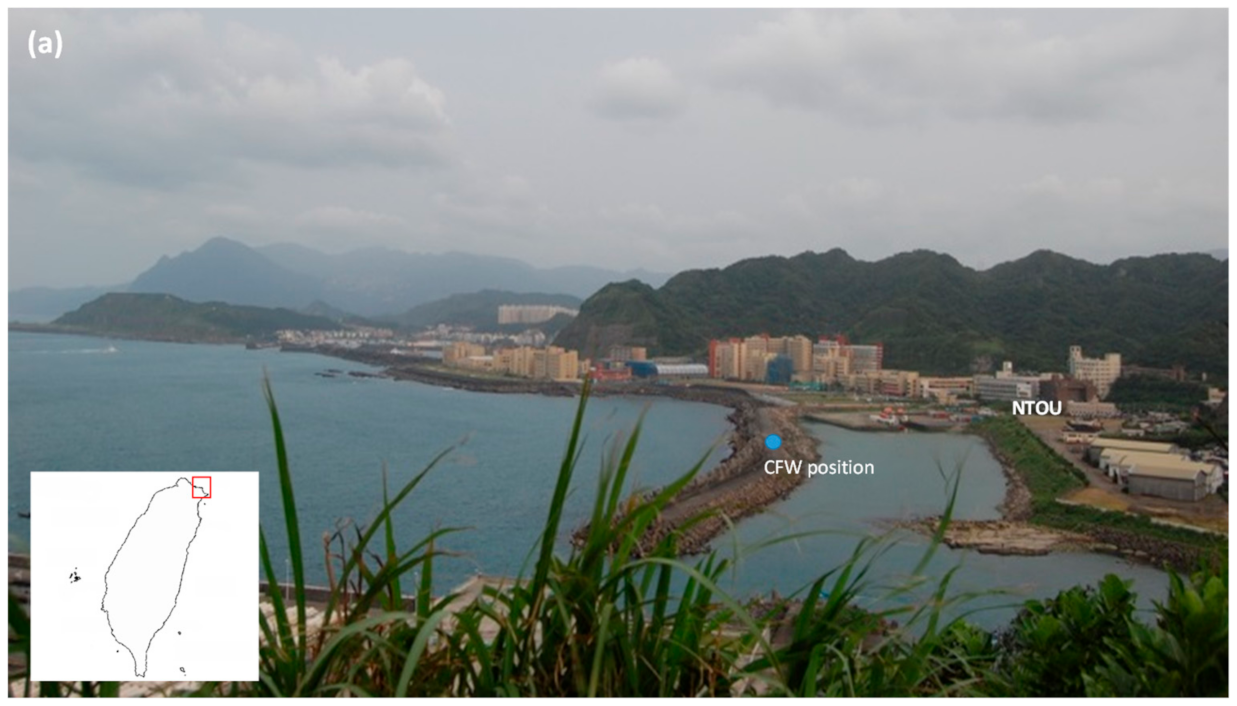

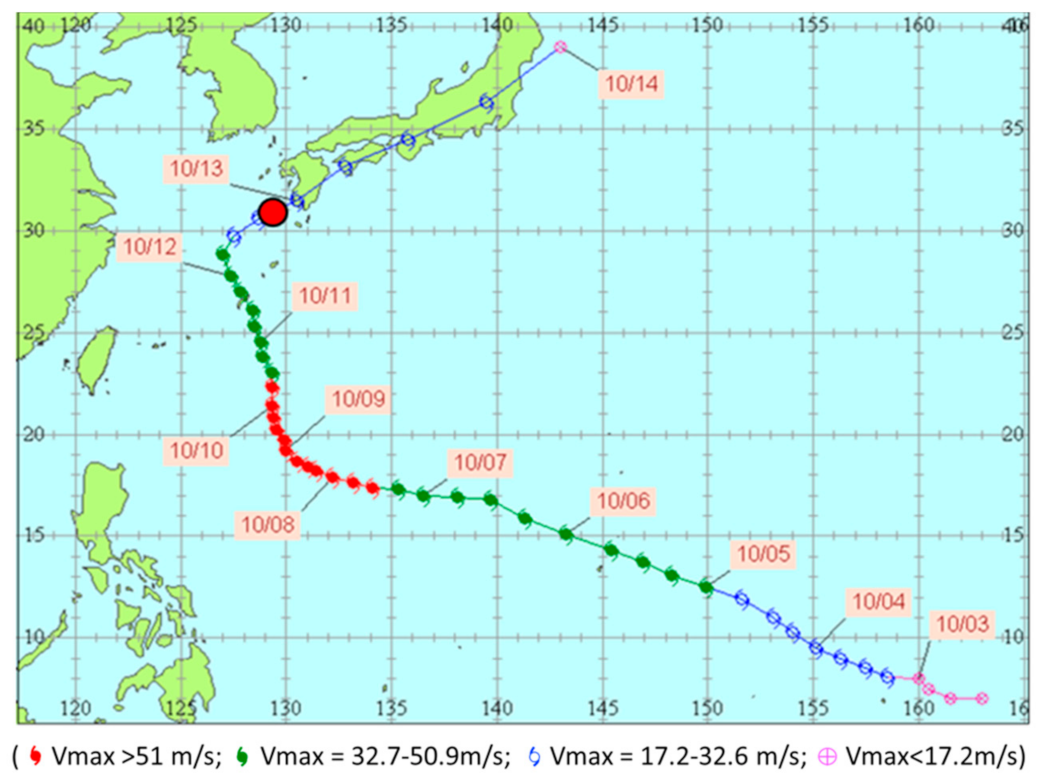
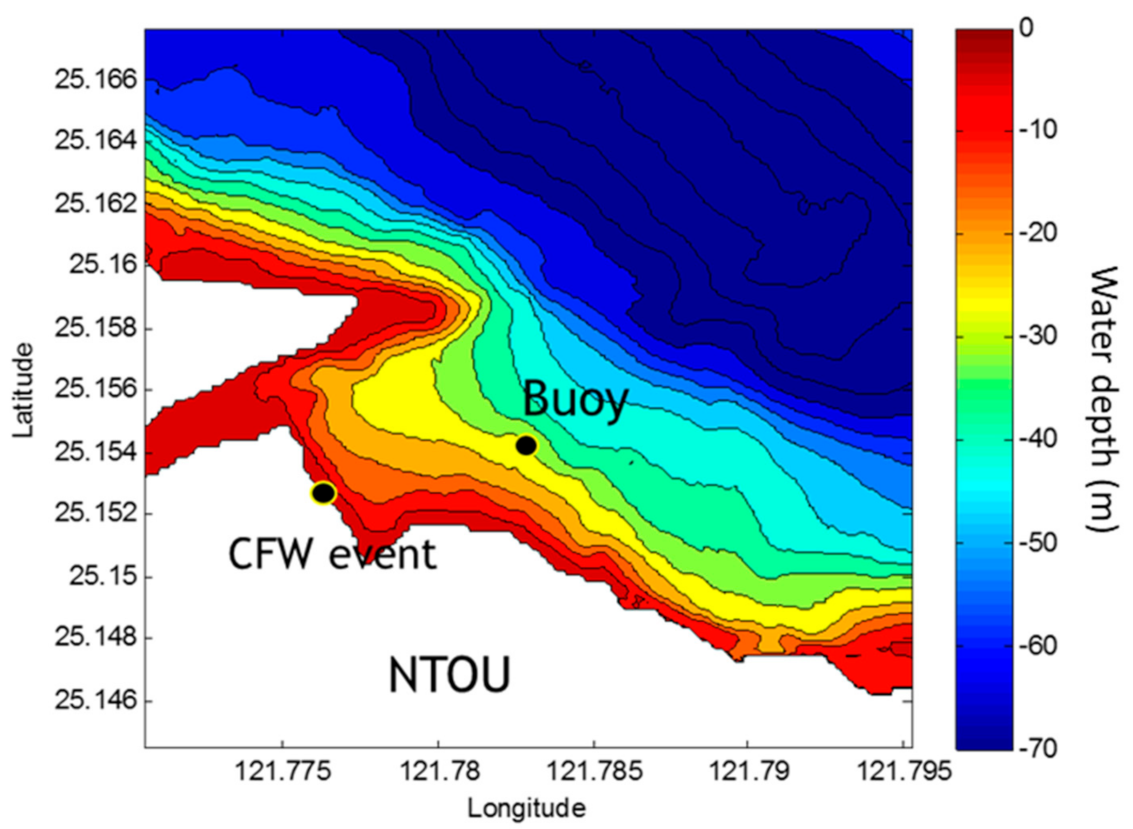




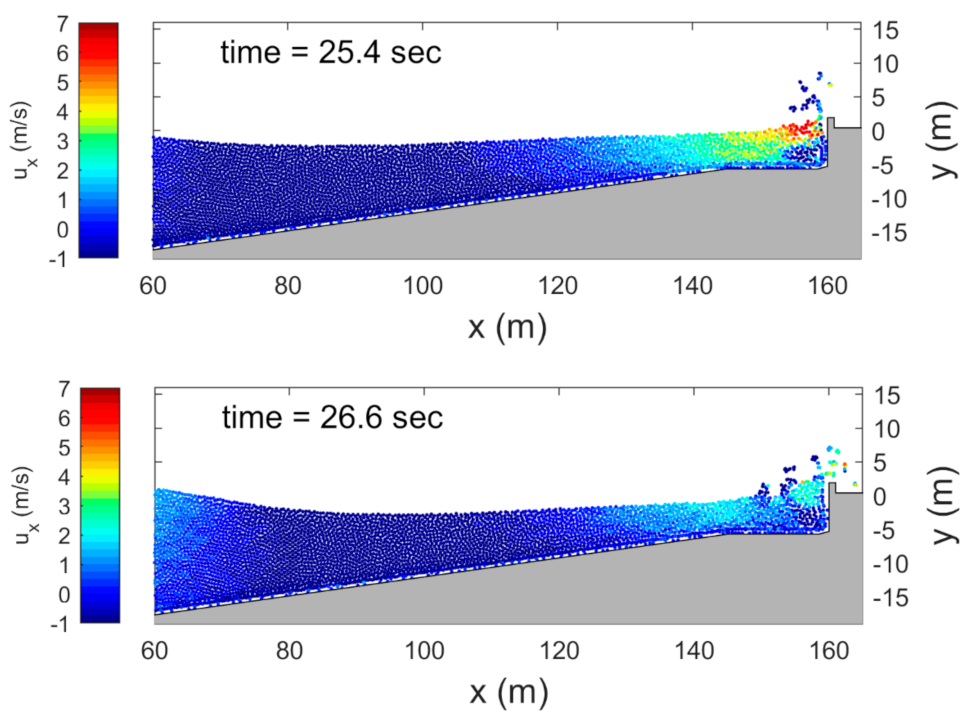

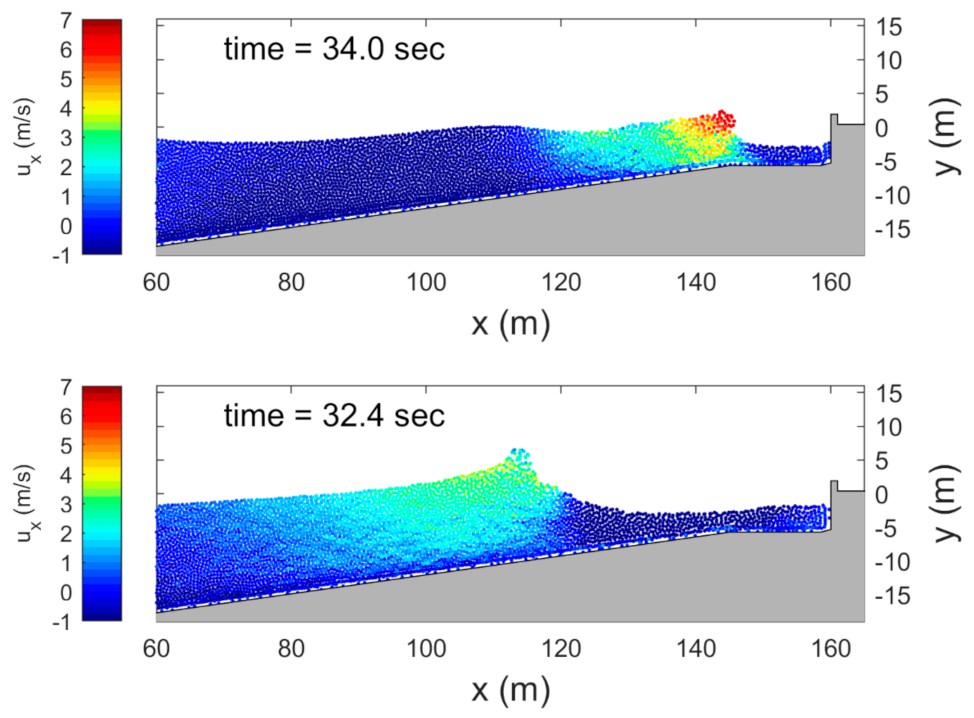
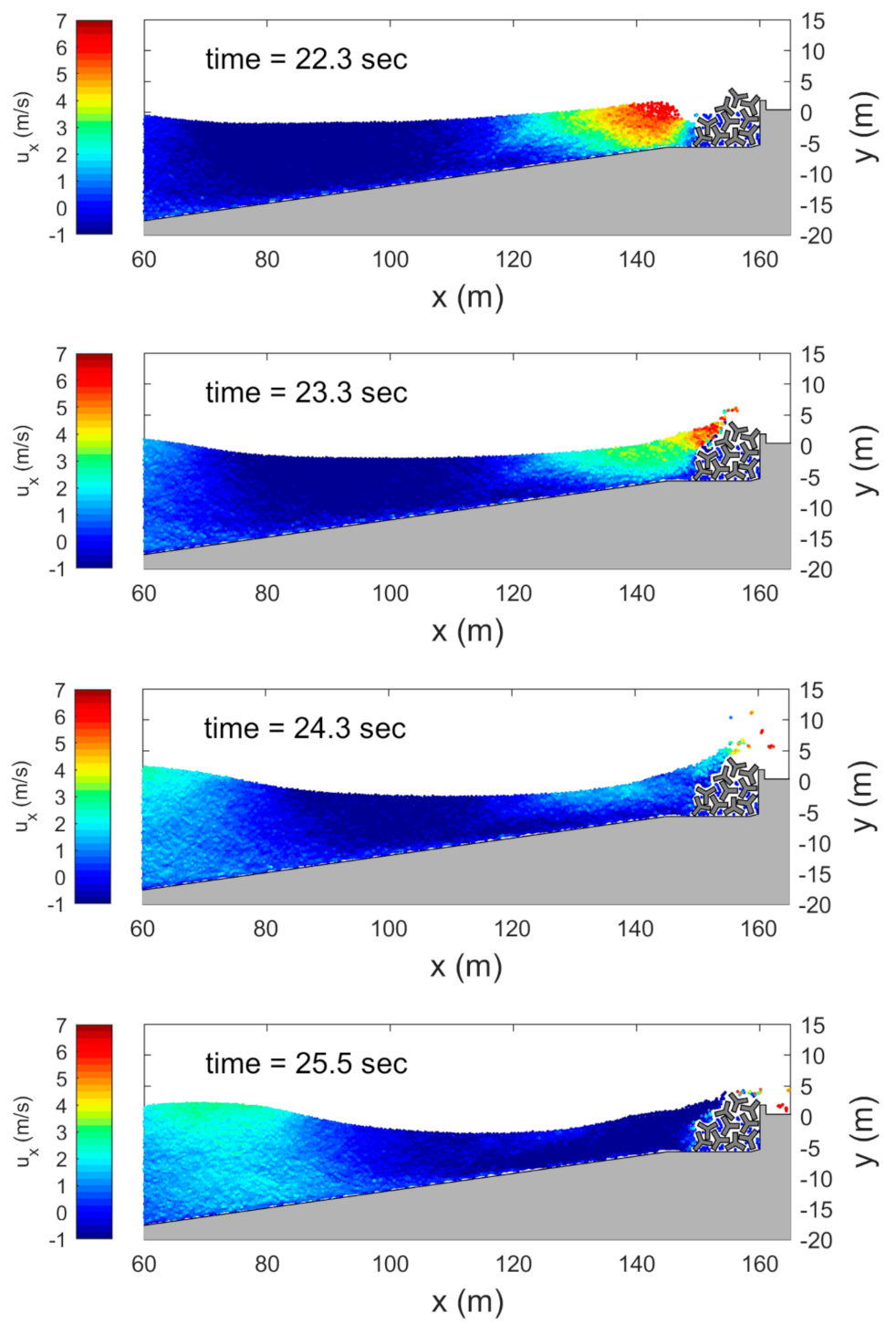
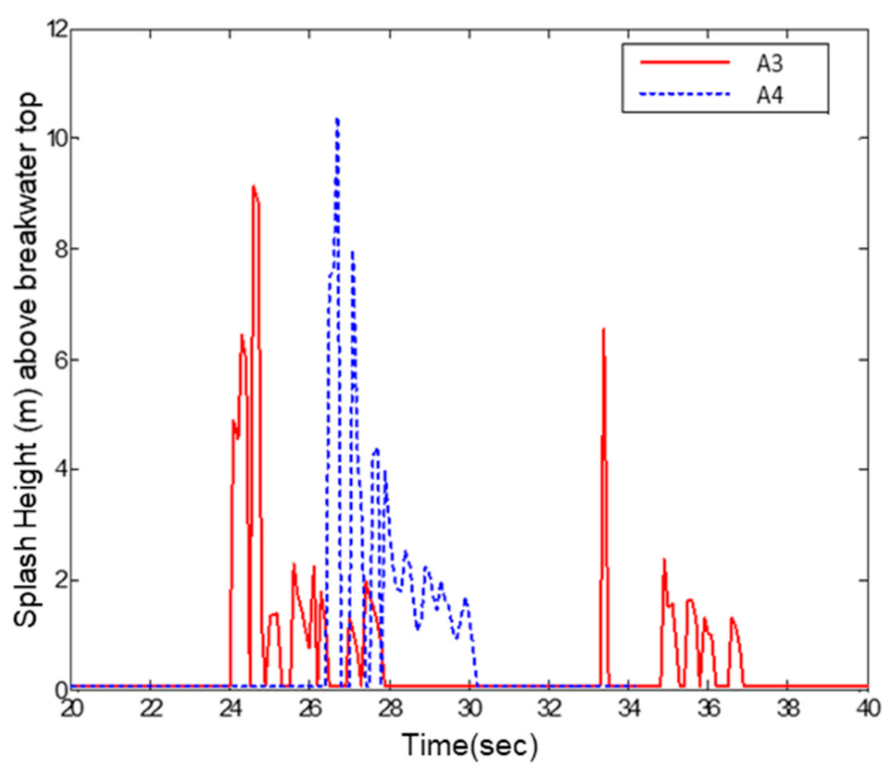
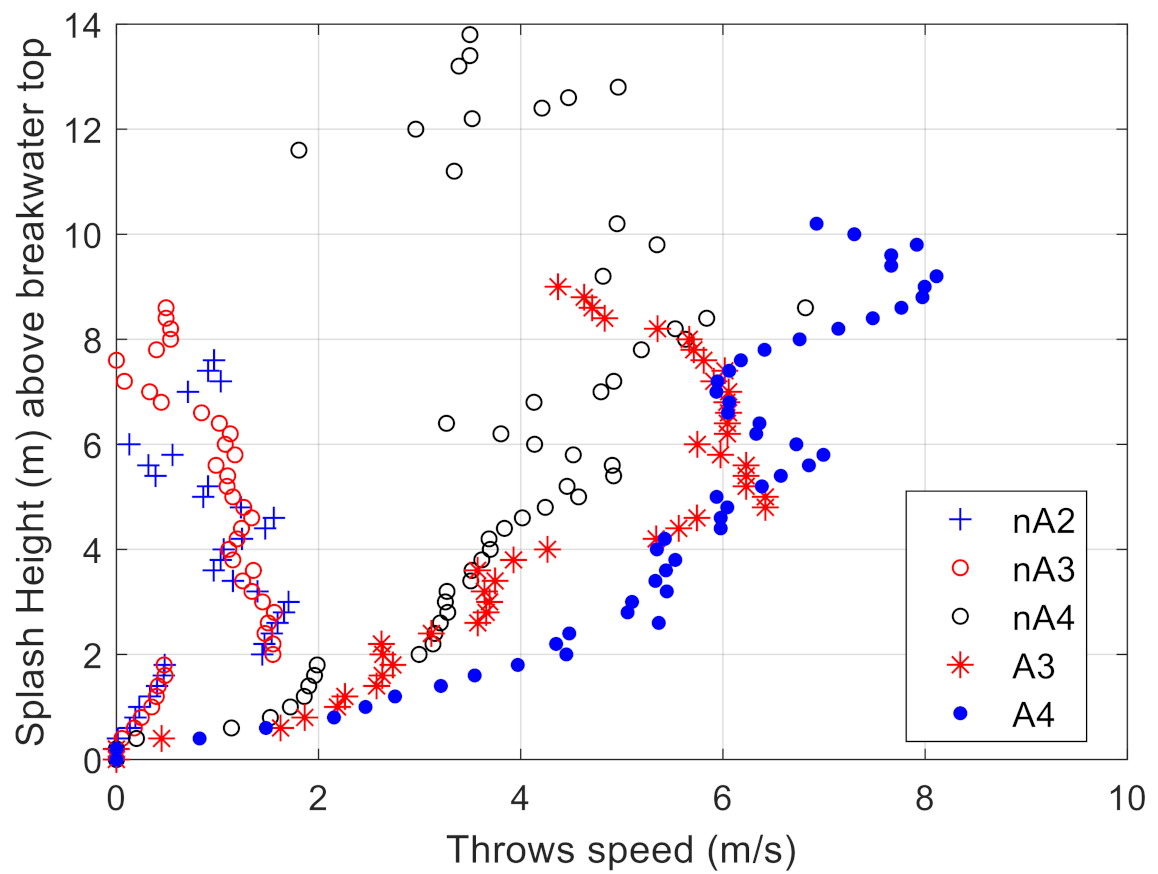
| Particle Size | dx = 0.5 m | dx = 0.3 m | dx = 0.15 m |
|---|---|---|---|
| Particle number | 10,156 | 26,001 | 104,004 |
| max. Hsplash (m) | 7.11 | 6.61 | 6.49 |
| mean throw speed (m/s) | 0.77 | 0.81 | 0.84 |
| tini (s) | 25.1 | 25.2 | 25.2 |
| Case | Wave Height (m) | Wave Period (s) | Impulsive Parameter (d*) | Armor Block Installation |
|---|---|---|---|---|
| nA1 | 1.5 | 8 | 0.76 | N |
| nA2 | 3.0 | 10 | 0.24 | N |
| nA3 | 4.5 | 12 | 0.11 | N |
| nA4 | 6.8 | 15 | 0.04 | N |
| A1 | 1.5 | 8 | 0.76 | Y |
| A2 | 3.0 | 10 | 0.24 | Y |
| A3 | 4.5 | 12 | 0.11 | Y |
| A4 | 6.8 | 15 | 0.04 | Y |
| Case | Max Splash Height (m) | Average Vertical Throw Speed (uz) (m/s) | Average Horizontal Throw Speed (ux) (m/s) | Discharge Rate (m2/s) |
|---|---|---|---|---|
| nA2 | 6.63 | 2.57 | 0.74 | 9.3 × 10−2 |
| nA3 | 6.61 | 3.67 | 0.81 | 1.5 × 10−1 |
| nA4 | 14.12 | 11.07 | 3.57 | 5.1 × 10−1 |
| A3 | 9.14 | 1.21 | 4.30 | 1.0 × 10−1 |
| A4 | 10.4 | 1.61 | 5.48 | 2.7 × 10−1 |
Publisher’s Note: MDPI stays neutral with regard to jurisdictional claims in published maps and institutional affiliations. |
© 2022 by the authors. Licensee MDPI, Basel, Switzerland. This article is an open access article distributed under the terms and conditions of the Creative Commons Attribution (CC BY) license (https://creativecommons.org/licenses/by/4.0/).
Share and Cite
Chen, Y.-C.; Doong, D.-J. Modeling Coastal Freak Wave Occurrence. J. Mar. Sci. Eng. 2022, 10, 323. https://doi.org/10.3390/jmse10030323
Chen Y-C, Doong D-J. Modeling Coastal Freak Wave Occurrence. Journal of Marine Science and Engineering. 2022; 10(3):323. https://doi.org/10.3390/jmse10030323
Chicago/Turabian StyleChen, Ying-Chih, and Dong-Jiing Doong. 2022. "Modeling Coastal Freak Wave Occurrence" Journal of Marine Science and Engineering 10, no. 3: 323. https://doi.org/10.3390/jmse10030323
APA StyleChen, Y.-C., & Doong, D.-J. (2022). Modeling Coastal Freak Wave Occurrence. Journal of Marine Science and Engineering, 10(3), 323. https://doi.org/10.3390/jmse10030323







